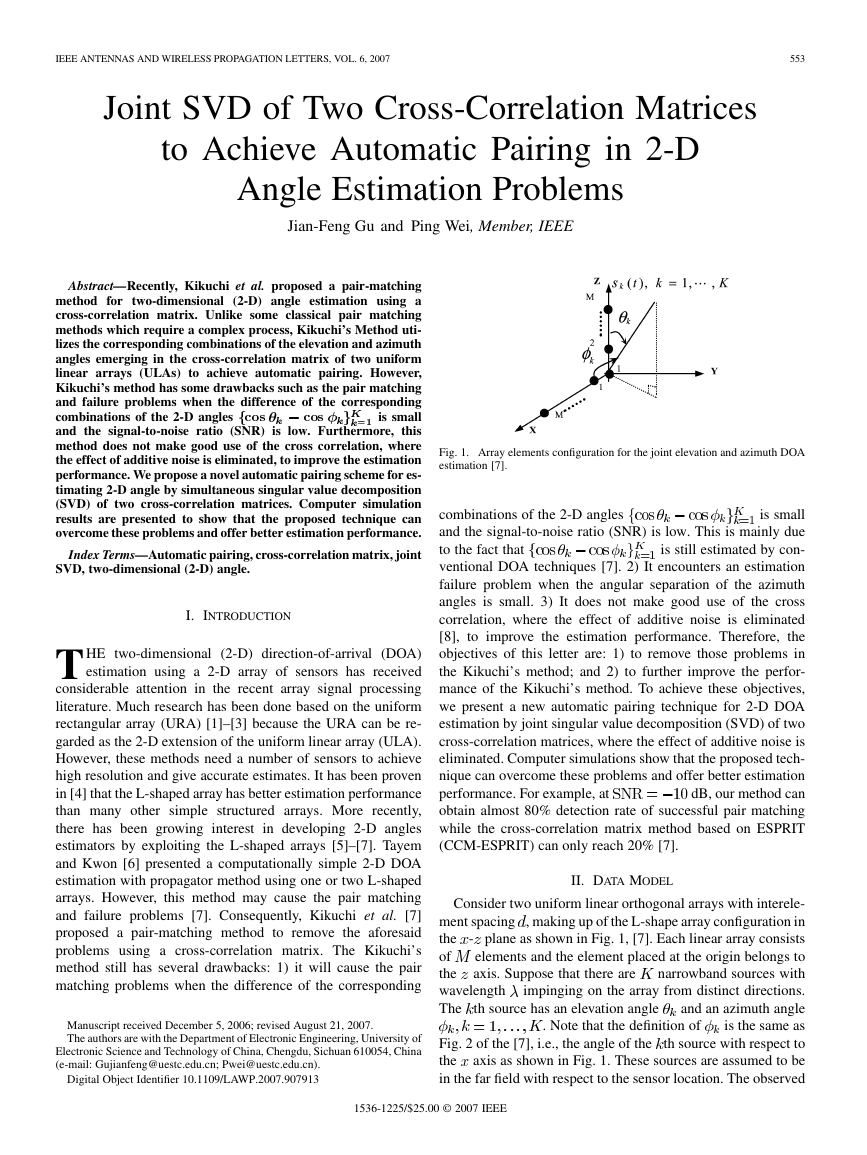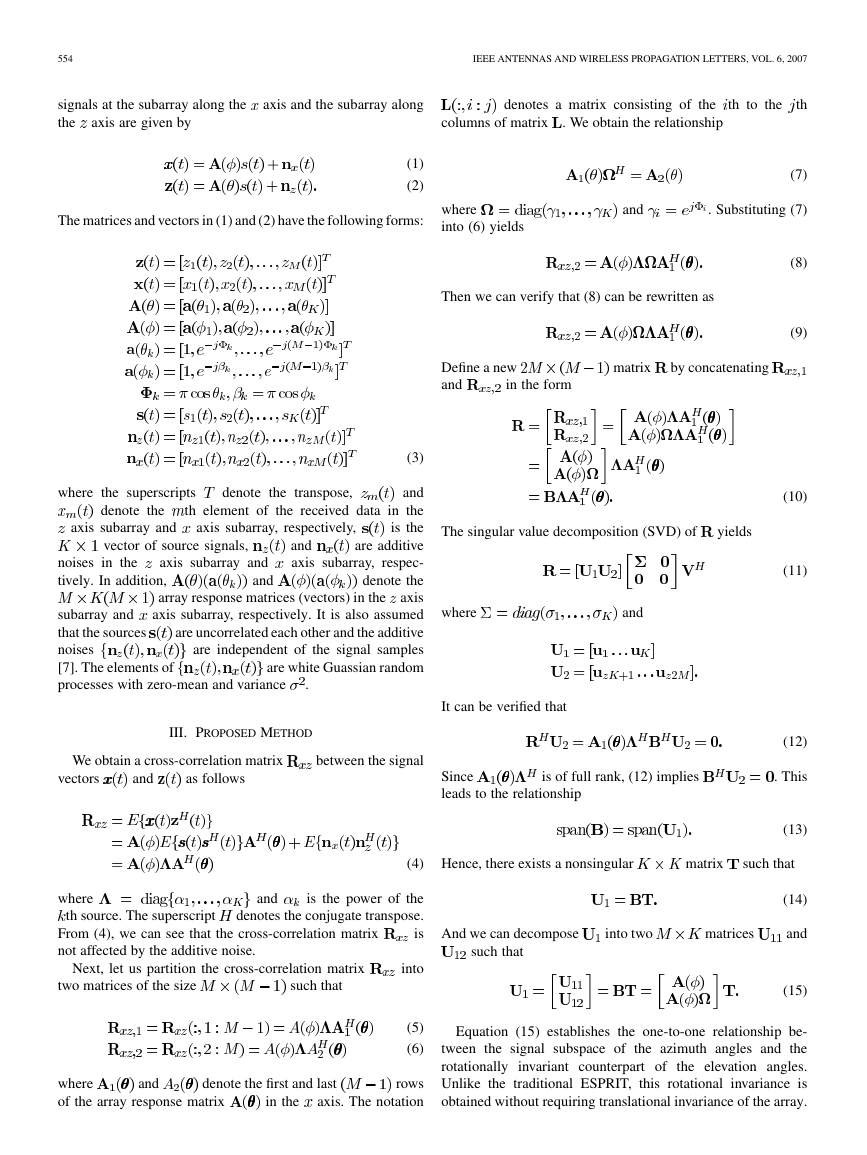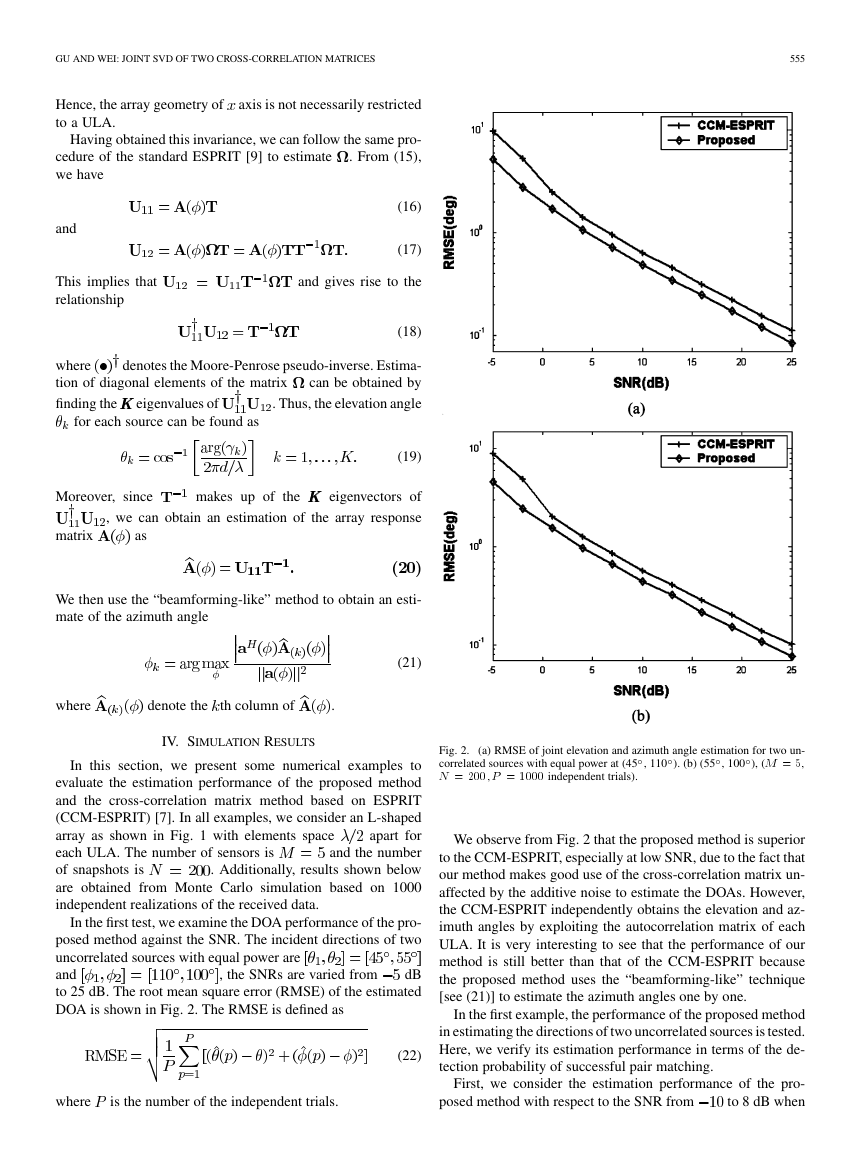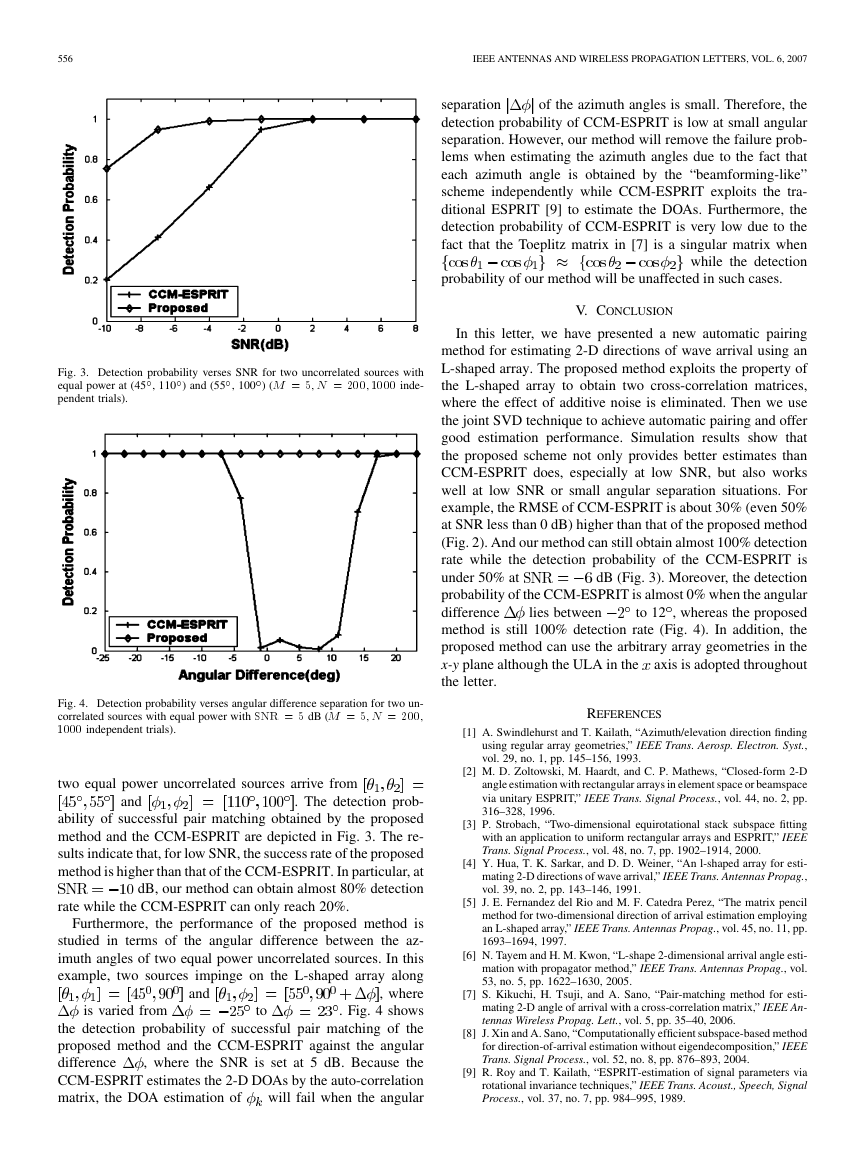IEEE ANTENNAS AND WIRELESS PROPAGATION LETTERS, VOL. 6, 2007
553
Joint SVD of Two Cross-Correlation Matrices
to Achieve Automatic Pairing in 2-D
Angle Estimation Problems
Jian-Feng Gu and Ping Wei, Member, IEEE
Abstract—Recently, Kikuchi et al. proposed a pair-matching
method for two-dimensional
(2-D) angle estimation using a
cross-correlation matrix. Unlike some classical pair matching
methods which require a complex process, Kikuchi’s Method uti-
lizes the corresponding combinations of the elevation and azimuth
angles emerging in the cross-correlation matrix of two uniform
linear arrays (ULAs) to achieve automatic pairing. However,
Kikuchi’s method has some drawbacks such as the pair matching
and failure problems when the difference of the corresponding
combinations of the 2-D angles cos
=1 is small
and the signal-to-noise ratio (SNR) is low. Furthermore, this
method does not make good use of the cross correlation, where
the effect of additive noise is eliminated, to improve the estimation
performance. We propose a novel automatic pairing scheme for es-
timating 2-D angle by simultaneous singular value decomposition
(SVD) of two cross-correlation matrices. Computer simulation
results are presented to show that the proposed technique can
overcome these problems and offer better estimation performance.
Index Terms—Automatic pairing, cross-correlation matrix, joint
cos
SVD, two-dimensional (2-D) angle.
I. INTRODUCTION
THE two-dimensional (2-D) direction-of-arrival (DOA)
estimation using a 2-D array of sensors has received
considerable attention in the recent array signal processing
literature. Much research has been done based on the uniform
rectangular array (URA) [1]–[3] because the URA can be re-
garded as the 2-D extension of the uniform linear array (ULA).
However, these methods need a number of sensors to achieve
high resolution and give accurate estimates. It has been proven
in [4] that the L-shaped array has better estimation performance
than many other simple structured arrays. More recently,
there has been growing interest in developing 2-D angles
estimators by exploiting the L-shaped arrays [5]–[7]. Tayem
and Kwon [6] presented a computationally simple 2-D DOA
estimation with propagator method using one or two L-shaped
arrays. However, this method may cause the pair matching
and failure problems [7]. Consequently, Kikuchi et al. [7]
proposed a pair-matching method to remove the aforesaid
problems using a cross-correlation matrix. The Kikuchi’s
method still has several drawbacks: 1) it will cause the pair
matching problems when the difference of the corresponding
Manuscript received December 5, 2006; revised August 21, 2007.
The authors are with the Department of Electronic Engineering, University of
Electronic Science and Technology of China, Chengdu, Sichuan 610054, China
(e-mail: Gujianfeng@uestc.edu.cn; Pwei@uestc.edu.cn).
Digital Object Identifier 10.1109/LAWP.2007.907913
Fig. 1. Array elements configuration for the joint elevation and azimuth DOA
estimation [7].
combinations of the 2-D angles
is small
and the signal-to-noise ratio (SNR) is low. This is mainly due
is still estimated by con-
to the fact that
ventional DOA techniques [7]. 2) It encounters an estimation
failure problem when the angular separation of the azimuth
angles is small. 3) It does not make good use of the cross
correlation, where the effect of additive noise is eliminated
[8], to improve the estimation performance. Therefore, the
objectives of this letter are: 1) to remove those problems in
the Kikuchi’s method; and 2) to further improve the perfor-
mance of the Kikuchi’s method. To achieve these objectives,
we present a new automatic pairing technique for 2-D DOA
estimation by joint singular value decomposition (SVD) of two
cross-correlation matrices, where the effect of additive noise is
eliminated. Computer simulations show that the proposed tech-
nique can overcome these problems and offer better estimation
dB, our method can
performance. For example, at
obtain almost 80% detection rate of successful pair matching
while the cross-correlation matrix method based on ESPRIT
(CCM-ESPRIT) can only reach 20% [7].
II. DATA MODEL
Consider two uniform linear orthogonal arrays with interele-
ment spacing , making up of the L-shape array configuration in
the - plane as shown in Fig. 1, [7]. Each linear array consists
elements and the element placed at the origin belongs to
of
axis. Suppose that there are
narrowband sources with
the
wavelength
impinging on the array from distinct directions.
and an azimuth angle
The th source has an elevation angle
is the same as
Fig. 2 of the [7], i.e., the angle of the th source with respect to
the
axis as shown in Fig. 1. These sources are assumed to be
in the far field with respect to the sensor location. The observed
. Note that the definition of
1536-1225/$25.00 © 2007 IEEE
�
554
IEEE ANTENNAS AND WIRELESS PROPAGATION LETTERS, VOL. 6, 2007
signals at the subarray along the
the
axis are given by
axis and the subarray along
denotes a matrix consisting of the th to the
th
columns of matrix . We obtain the relationship
The matrices and vectors in (1) and (2) have the following forms:
where
into (6) yields
(1)
(2)
(7)
and
. Substituting (7)
Then we can verify that (8) can be rewritten as
Define a new
and
in the form
matrix
by concatenating
(3)
The singular value decomposition (SVD) of
yields
where
and
where the superscripts
denote the
axis subarray and
noises in the
tively. In addition,
vector of source signals,
denote the transpose,
axis subarray, respectively,
axis subarray and
and
and
th element of the received data in the
is the
and
are additive
axis subarray, respec-
denote the
array response matrices (vectors) in the
axis
axis subarray, respectively. It is also assumed
are uncorrelated each other and the additive
are independent of the signal samples
are white Guassian random
subarray and
that the sources
noises
[7]. The elements of
processes with zero-mean and variance
.
It can be verified that
III. PROPOSED METHOD
We obtain a cross-correlation matrix
between the signal
vectors
and
as follows
Since
leads to the relationship
is of full rank, (12) implies
(8)
(9)
(10)
(11)
(12)
. This
(13)
(4)
Hence, there exists a nonsingular
matrix
such that
where
th source. The superscript
and
is the power of the
denotes the conjugate transpose.
is
From (4), we can see that the cross-correlation matrix
not affected by the additive noise.
Next, let us partition the cross-correlation matrix
into
two matrices of the size
such that
(5)
(6)
where
of the array response matrix
and
denote the first and last
rows
axis. The notation
in the
And we can decompose
into two
matrices
such that
(14)
and
(15)
Equation (15) establishes the one-to-one relationship be-
tween the signal subspace of the azimuth angles and the
rotationally invariant counterpart of
the elevation angles.
Unlike the traditional ESPRIT, this rotational invariance is
obtained without requiring translational invariance of the array.
�
GU AND WEI: JOINT SVD OF TWO CROSS-CORRELATION MATRICES
555
Hence, the array geometry of
to a ULA.
axis is not necessarily restricted
Having obtained this invariance, we can follow the same pro-
. From (15),
cedure of the standard ESPRIT [9] to estimate
we have
and
This implies that
relationship
(16)
(17)
and gives rise to the
(18)
where
tion of diagonal elements of the matrix
finding the
denotes the Moore-Penrose pseudo-inverse. Estima-
can be obtained by
. Thus, the elevation angle
eigenvalues of
for each source can be found as
(19)
Moreover, since
eigenvectors of
, we can obtain an estimation of the array response
makes up of the
matrix
as
We then use the “beamforming-like” method to obtain an esti-
mate of the azimuth angle
(21)
where
denote the th column of
.
IV. SIMULATION RESULTS
In this section, we present some numerical examples to
evaluate the estimation performance of the proposed method
and the cross-correlation matrix method based on ESPRIT
(CCM-ESPRIT) [7]. In all examples, we consider an L-shaped
apart for
array as shown in Fig. 1 with elements space
each ULA. The number of sensors is
and the number
. Additionally, results shown below
of snapshots is
are obtained from Monte Carlo simulation based on 1000
independent realizations of the received data.
In the first test, we examine the DOA performance of the pro-
posed method against the SNR. The incident directions of two
uncorrelated sources with equal power are
and
dB
to 25 dB. The root mean square error (RMSE) of the estimated
DOA is shown in Fig. 2. The RMSE is defined as
, the SNRs are varied from
(22)
where
is the number of the independent trials.
Fig. 2.
(a) RMSE of joint elevation and azimuth angle estimation for two un-
correlated sources with equal power at (45 , 110 ). (b) (55 , 100 ), (M = 5;
N = 200; P = 1000 independent trials).
We observe from Fig. 2 that the proposed method is superior
to the CCM-ESPRIT, especially at low SNR, due to the fact that
our method makes good use of the cross-correlation matrix un-
affected by the additive noise to estimate the DOAs. However,
the CCM-ESPRIT independently obtains the elevation and az-
imuth angles by exploiting the autocorrelation matrix of each
ULA. It is very interesting to see that the performance of our
method is still better than that of the CCM-ESPRIT because
the proposed method uses the “beamforming-like” technique
[see (21)] to estimate the azimuth angles one by one.
In the first example, the performance of the proposed method
in estimating the directions of two uncorrelated sources is tested.
Here, we verify its estimation performance in terms of the de-
tection probability of successful pair matching.
First, we consider the estimation performance of the pro-
to 8 dB when
posed method with respect to the SNR from
�
556
IEEE ANTENNAS AND WIRELESS PROPAGATION LETTERS, VOL. 6, 2007
of the azimuth angles is small. Therefore, the
separation
detection probability of CCM-ESPRIT is low at small angular
separation. However, our method will remove the failure prob-
lems when estimating the azimuth angles due to the fact that
each azimuth angle is obtained by the “beamforming-like”
scheme independently while CCM-ESPRIT exploits the tra-
ditional ESPRIT [9] to estimate the DOAs. Furthermore, the
detection probability of CCM-ESPRIT is very low due to the
fact that the Toeplitz matrix in [7] is a singular matrix when
while the detection
probability of our method will be unaffected in such cases.
V. CONCLUSION
In this letter, we have presented a new automatic pairing
method for estimating 2-D directions of wave arrival using an
L-shaped array. The proposed method exploits the property of
the L-shaped array to obtain two cross-correlation matrices,
where the effect of additive noise is eliminated. Then we use
the joint SVD technique to achieve automatic pairing and offer
good estimation performance. Simulation results show that
the proposed scheme not only provides better estimates than
CCM-ESPRIT does, especially at low SNR, but also works
well at low SNR or small angular separation situations. For
example, the RMSE of CCM-ESPRIT is about 30% (even 50%
at SNR less than 0 dB) higher than that of the proposed method
(Fig. 2). And our method can still obtain almost 100% detection
rate while the detection probability of the CCM-ESPRIT is
dB (Fig. 3). Moreover, the detection
under 50% at
probability of the CCM-ESPRIT is almost 0% when the angular
to 12 , whereas the proposed
difference
method is still 100% detection rate (Fig. 4). In addition, the
proposed method can use the arbitrary array geometries in the
x-y plane although the ULA in the
axis is adopted throughout
the letter.
lies between
REFERENCES
[1] A. Swindlehurst and T. Kailath, “Azimuth/elevation direction finding
using regular array geometries,” IEEE Trans. Aerosp. Electron. Syst.,
vol. 29, no. 1, pp. 145–156, 1993.
[2] M. D. Zoltowski, M. Haardt, and C. P. Mathews, “Closed-form 2-D
angle estimation with rectangular arrays in element space or beamspace
via unitary ESPRIT,” IEEE Trans. Signal Process., vol. 44, no. 2, pp.
316–328, 1996.
[3] P. Strobach, “Two-dimensional equirotational stack subspace fitting
with an application to uniform rectangular arrays and ESPRIT,” IEEE
Trans. Signal Process., vol. 48, no. 7, pp. 1902–1914, 2000.
[4] Y. Hua, T. K. Sarkar, and D. D. Weiner, “An l-shaped array for esti-
mating 2-D directions of wave arrival,” IEEE Trans. Antennas Propag.,
vol. 39, no. 2, pp. 143–146, 1991.
[5] J. E. Fernandez del Rio and M. F. Catedra Perez, “The matrix pencil
method for two-dimensional direction of arrival estimation employing
an L-shaped array,” IEEE Trans. Antennas Propag., vol. 45, no. 11, pp.
1693–1694, 1997.
[6] N. Tayem and H. M. Kwon, “L-shape 2-dimensional arrival angle esti-
mation with propagator method,” IEEE Trans. Antennas Propag., vol.
53, no. 5, pp. 1622–1630, 2005.
[7] S. Kikuchi, H. Tsuji, and A. Sano, “Pair-matching method for esti-
mating 2-D angle of arrival with a cross-correlation matrix,” IEEE An-
tennas Wireless Propag. Lett., vol. 5, pp. 35–40, 2006.
[8] J. Xin and A. Sano, “Computationally efficient subspace-based method
for direction-of-arrival estimation without eigendecomposition,” IEEE
Trans. Signal Process., vol. 52, no. 8, pp. 876–893, 2004.
[9] R. Roy and T. Kailath, “ESPRIT-estimation of signal parameters via
rotational invariance techniques,” IEEE Trans. Acoust., Speech, Signal
Process., vol. 37, no. 7, pp. 984–995, 1989.
Fig. 3. Detection probability verses SNR for two uncorrelated sources with
equal power at (45 , 110 ) and (55 , 100 ) (M = 5; N = 200; 1000 inde-
pendent trials).
Fig. 4. Detection probability verses angular difference separation for two un-
correlated sources with equal power with SNR = 5 dB (M = 5; N = 200;
1000 independent trials).
two equal power uncorrelated sources arrive from
and
. The detection prob-
ability of successful pair matching obtained by the proposed
method and the CCM-ESPRIT are depicted in Fig. 3. The re-
sults indicate that, for low SNR, the success rate of the proposed
method is higher than that of the CCM-ESPRIT. In particular, at
dB, our method can obtain almost 80% detection
rate while the CCM-ESPRIT can only reach 20%.
Furthermore, the performance of the proposed method is
studied in terms of the angular difference between the az-
imuth angles of two equal power uncorrelated sources. In this
example, two sources impinge on the L-shaped array along
, where
. Fig. 4 shows
the detection probability of successful pair matching of the
proposed method and the CCM-ESPRIT against the angular
, where the SNR is set at 5 dB. Because the
difference
CCM-ESPRIT estimates the 2-D DOAs by the auto-correlation
will fail when the angular
matrix, the DOA estimation of
is varied from
and
to
�








 2023年江西萍乡中考道德与法治真题及答案.doc
2023年江西萍乡中考道德与法治真题及答案.doc 2012年重庆南川中考生物真题及答案.doc
2012年重庆南川中考生物真题及答案.doc 2013年江西师范大学地理学综合及文艺理论基础考研真题.doc
2013年江西师范大学地理学综合及文艺理论基础考研真题.doc 2020年四川甘孜小升初语文真题及答案I卷.doc
2020年四川甘孜小升初语文真题及答案I卷.doc 2020年注册岩土工程师专业基础考试真题及答案.doc
2020年注册岩土工程师专业基础考试真题及答案.doc 2023-2024学年福建省厦门市九年级上学期数学月考试题及答案.doc
2023-2024学年福建省厦门市九年级上学期数学月考试题及答案.doc 2021-2022学年辽宁省沈阳市大东区九年级上学期语文期末试题及答案.doc
2021-2022学年辽宁省沈阳市大东区九年级上学期语文期末试题及答案.doc 2022-2023学年北京东城区初三第一学期物理期末试卷及答案.doc
2022-2023学年北京东城区初三第一学期物理期末试卷及答案.doc 2018上半年江西教师资格初中地理学科知识与教学能力真题及答案.doc
2018上半年江西教师资格初中地理学科知识与教学能力真题及答案.doc 2012年河北国家公务员申论考试真题及答案-省级.doc
2012年河北国家公务员申论考试真题及答案-省级.doc 2020-2021学年江苏省扬州市江都区邵樊片九年级上学期数学第一次质量检测试题及答案.doc
2020-2021学年江苏省扬州市江都区邵樊片九年级上学期数学第一次质量检测试题及答案.doc 2022下半年黑龙江教师资格证中学综合素质真题及答案.doc
2022下半年黑龙江教师资格证中学综合素质真题及答案.doc